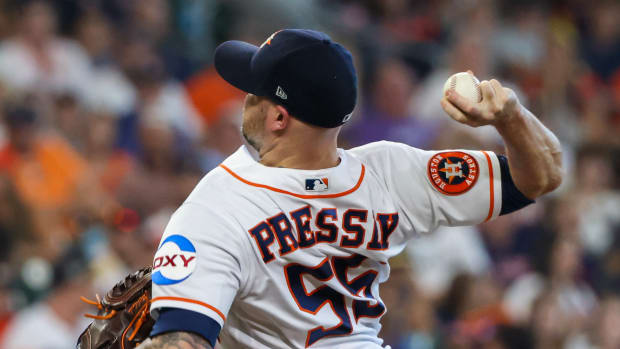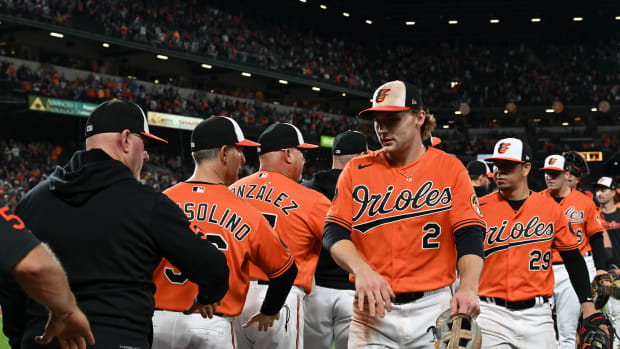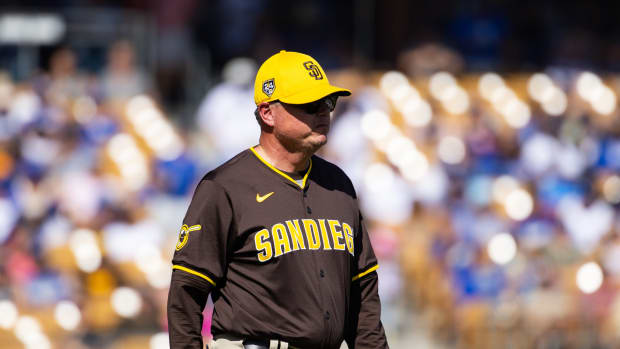As Adam Wainwright Faces an Uncertain Future, One SI Writer Relishes Chance to See a Final Curveball
CHICAGO — They’re magic, sleight of hand, muscles’ devious memory. Adam Wainwright’s curveballs are dirty tricks batters have been able to anticipate for more than a decade now—and still, they fall for them, although maybe not so often as they used to.
The best thing about a Wainwright curveball—a vintage, prime-of-his-career, 75-mph beauty—is the look of the batters who stand still, certain and then incredulous. The swings and misses, those are plenty fun, but they’ve got nothing on the blank, soul-sucked stares. You’re probably remembering Carlos Beltran back in 2006, when he stood in the batter’s box as the Mets’ final hope in the NLCS. He took strike three looking. And for as still as he stood as pitch crossed plate, he twirled his bat and jumped backward at the call, like a man who’d stepped on something sharp, like he’d better get away fast from whatever that just was.
The Mets fan who happened to be sitting next to me at Wrigley Field on Friday afternoon mentioned that strike just about as soon as I told him why I was there, at the end of the 13th row in section 137, shivering and soggy and alone. I explained that this game could very well be Wainwright’s last in a Cardinals uniform, that I’m a sports writer, that I live in Chicago, that I felt I had to experience it, and from a green Wrigley seat, not the press box. He seemed to understand, and then he brought up Beltran and that indelible pitch.
Sporty Spice: Matt Carpenter Helped Save the Cardinals' Season. He Thanks His Salsa.
It was one for the Wainwright highlight reel. A week later, that reel would get an addition when the rookie struck out Brandon Inge on a slider to win the Cardinals their first World Series since 1982. There was the pitch—unlike Beltran, Inge swung—and then the follow-up, Wainwright and Yadier Molina meeting between the mound and home plate, jumping into the air to embrace. Five years later, when St. Louis won another title, Wainwright was out after Tommy John surgery, so those two 2006 strikes are almost certainly the most important pitches of his career.
And somehow, I rarely think of them. The Wainwright who stepped in as the Cardinals’ emergency closer when Jason Isringhausen hurt his hip and missed the playoffs has been a distant memory for seasons. That pitcher was a rookie, the kid Walt Jocketty traded J.D. Drew to get. He’d hit a home run in his first-ever MLB at-bat, as the second pitcher in a bullpen start at AT&T Park. He was supposed to be good, we knew that September. By October, he was going to be good. The playoff run made that much clear—but the Adam Wainwright of the future tense seems an eon ago, and his 13 years with the Cardinals are best remembered in the macro, not the micro.
There are the game-on-the-line, season-on-the-line pitches, which are no more beautiful than the Wednesday-afternoon-in-May pitches, or the coasting-to-the-division pitches, or the eliminated-yesterday pitches. Wainwright’s career isn’t special for the drama. It’s exquisite for the consistency, for the 352 games, the 148 wins and 1,932 innings, for that feeling when he’s dealing that anyone or anything—Clayton Kershaw, the Cubs, whatever most daunting adversary that day has conjured—is nothing more than a speed bump.
Friday for the Cardinals was an 8-4 loss to the Cubs, and it felt like an ending: of playoff hopes (though Mike Schildt's team isn't technically eliminated) and of Wainwright’s time in St. Louis. The pitcher’s contract is up at the end of the year and he’s expressed a desire to keep playing. St. Louis, meanwhile, has a stable of young starters who more than pulled their weight in the second half of 2018. For the first time ever, the interests of Wainwright and his baseball team may soon be at odds.
What was notable about Wainwright getting Friday’s start was not the runs he allowed—four in five innings, to go along with five hits and seven strikeouts—but the fact that he was out there at all, in a game that felt do-or-die for the Cardinals, after an injury-plagued season. I’ll admit to baseball hubris: I worried when he returned to the rotation in September. I worried, and then he pitched steady and solid, keeping the Cardinals in every game he was handed and dazzling in one, on Sept. 16 against the Dodgers. If the team that I don’t know how not to love ends up missing the playoffs, Adam Wainwright will be the last man to blame.
On Friday, as Wainwright walked from the Wrigley Field bullpen to home plate, down the first-base line, I sat maybe 100 feet away. Kyle Hendricks’s walk-up song, Aerosmith’s “Sweet Emotion,” blasted from the ballpark’s sound system, and damn if it wasn’t just that. The two longest-tenured Cardinals, Molina and Wainwright, strolled to the dugout, looking not straight ahead to the diamond and the afternoon, but at each other. They’ve been partners and foils, the pitcher’s sunny to the catcher’s surly, for 13 years, and they knew what the afternoon might mean.
In the summer of 2006, when Wainwright was a rookie without a role, I had just graduated high school. In late May, I attended a graduation brunch for a friend on the top floor of a downtown St. Louis hotel, at one of those rotating restaurants people used to find fascinating. At that point, I hadn’t yet been inside the brand-new Busch Stadium, which had opened in April. Old Busch, the repository of all my baseball memories, was smithereens, and at that brunch, our table slowly rotated past the new ballpark, allowing us a birds-eye view from the table. We were toasting with orange juice to the future when I realized: This new ballpark was going to be part of a St. Louis that didn’t include me, and soon enough, Cardinals games would be a two-hour flight away.
The Everlasting Legacy of Melissa Ludtke, Who Dared to Join the Boys Club of the Baseball Press
I was at school at Georgetown by the time Wainwright became the closer, but as the Cardinals went on that improbable playoff run, I lucked out. Over fall break, I got to attend an NLDS game against the Padres. Parents weekend fell in the middle of the NLCS, so I got to watch three games with my dad on television in D.C. But the World Series was another story: I had no trips home planned, no guests booked to visit. I had a few friends from St. Louis at school, and we watched the games together, but my deepest recollection of that series is of a sense of aloneness. I missed my high school friends, my brother, my mom and dad—the people who I’d learned to love baseball alongside. It never occurred to me to skip a class or two and book a flight home for a game. And so when Wainwright struck out Inge to give the Cardinals their first title of my lifetime, I was watching in a dorm room, and I called my brother, and when I hung up, a big crowd of us ran outside. Somehow all of the Cardinals fans on campus converged, and for the first time all fall, I felt connected to something.
I was alone again on Friday, by choice. The legs of my jeans were drenched by the end of it, and my glasses were so coated with congealed rainwater that the world had foggy edges. A pack of women in my row decided the perfect moment to retreat from the weather was at the exact second Wainwright threw his final pitch of the day. It was a curveball, of course, for a strikeout of Javier Baez. I missed it, the ending I’d come looking for. I was livid for a moment, until I considered the luck I had to have been able to come looking at all, in Chicago, at Wrigley, in this seat I’d randomly selected.
Three innings earlier, in that very same seat, I’d stared up into the sky to see a foul ball careening on a collision course, it seemed, with my head. It was still up there, a speck against the cloud but definitely trained on me, when I froze. In the split second before I had the sense to duck, one cogent, calming thought crossed my mind: The ball that’s about to knock me out was once an Adam Wainwright curveball.



































